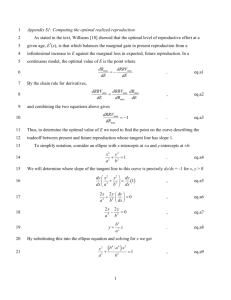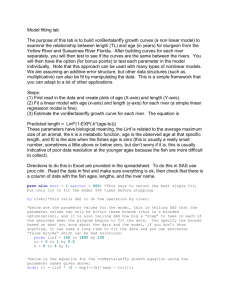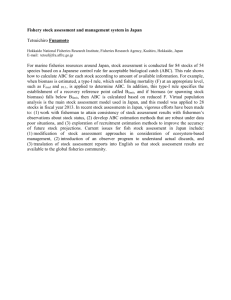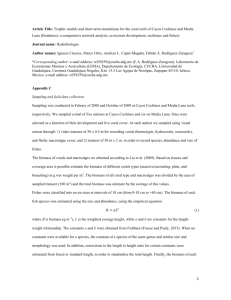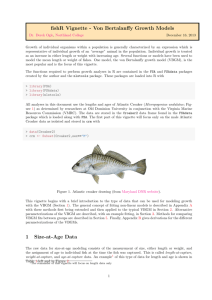Population Dynamics: Introduction and Exercises
advertisement
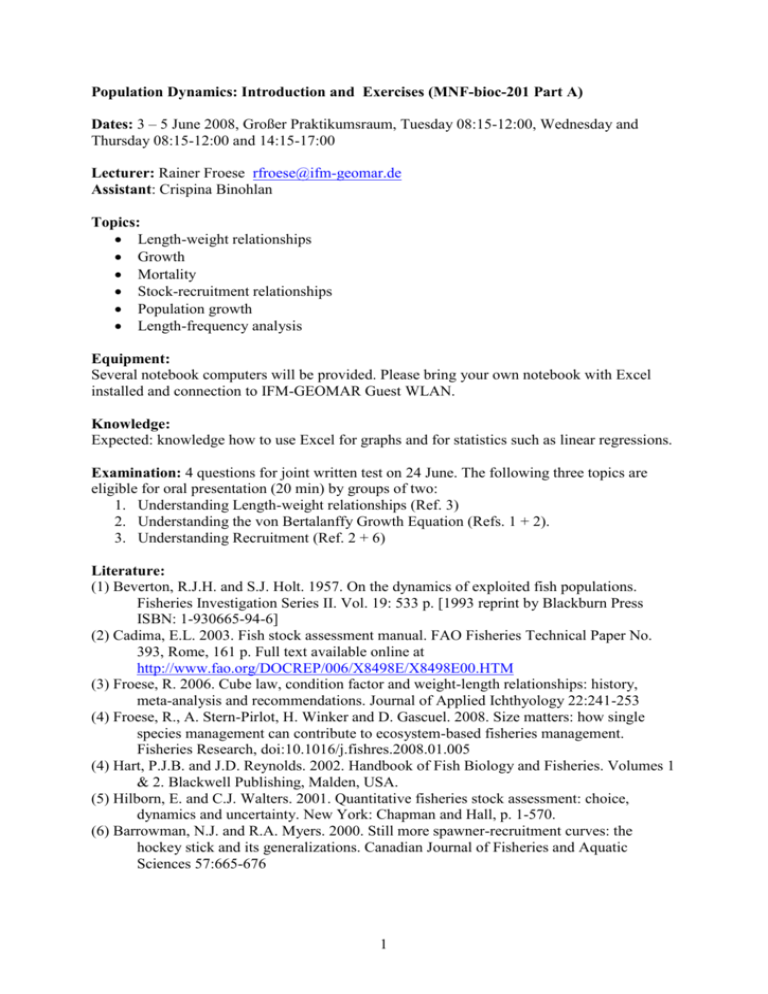
Population Dynamics: Introduction and Exercises (MNF-bioc-201 Part A) Dates: 3 – 5 June 2008, Großer Praktikumsraum, Tuesday 08:15-12:00, Wednesday and Thursday 08:15-12:00 and 14:15-17:00 Lecturer: Rainer Froese rfroese@ifm-geomar.de Assistant: Crispina Binohlan Topics: Length-weight relationships Growth Mortality Stock-recruitment relationships Population growth Length-frequency analysis Equipment: Several notebook computers will be provided. Please bring your own notebook with Excel installed and connection to IFM-GEOMAR Guest WLAN. Knowledge: Expected: knowledge how to use Excel for graphs and for statistics such as linear regressions. Examination: 4 questions for joint written test on 24 June. The following three topics are eligible for oral presentation (20 min) by groups of two: 1. Understanding Length-weight relationships (Ref. 3) 2. Understanding the von Bertalanffy Growth Equation (Refs. 1 + 2). 3. Understanding Recruitment (Ref. 2 + 6) Literature: (1) Beverton, R.J.H. and S.J. Holt. 1957. On the dynamics of exploited fish populations. Fisheries Investigation Series II. Vol. 19: 533 p. [1993 reprint by Blackburn Press ISBN: 1-930665-94-6] (2) Cadima, E.L. 2003. Fish stock assessment manual. FAO Fisheries Technical Paper No. 393, Rome, 161 p. Full text available online at http://www.fao.org/DOCREP/006/X8498E/X8498E00.HTM (3) Froese, R. 2006. Cube law, condition factor and weight-length relationships: history, meta-analysis and recommendations. Journal of Applied Ichthyology 22:241-253 (4) Froese, R., A. Stern-Pirlot, H. Winker and D. Gascuel. 2008. Size matters: how single species management can contribute to ecosystem-based fisheries management. Fisheries Research, doi:10.1016/j.fishres.2008.01.005 (4) Hart, P.J.B. and J.D. Reynolds. 2002. Handbook of Fish Biology and Fisheries. Volumes 1 & 2. Blackwell Publishing, Malden, USA. (5) Hilborn, E. and C.J. Walters. 2001. Quantitative fisheries stock assessment: choice, dynamics and uncertainty. New York: Chapman and Hall, p. 1-570. (6) Barrowman, N.J. and R.A. Myers. 2000. Still more spawner-recruitment curves: the hockey stick and its generalizations. Canadian Journal of Fisheries and Aquatic Sciences 57:665-676 1 Session 1. Intro A: Introduction to Fisheries Management - Fish stocks are a renewable resource. - Sustainable fisheries take (part of) the surplus production with least possible impact on the stock and on the ecosystem (EBFM). - Stock assessment estimates length-weight relationships, growth, mortality, maturity, fecundity, population size and rate of increase. - Cohorts are year-classes of individuals; their life cycle is typically used to estimate life history traits; these traits also apply to the whole stock if it is in a stable state. Intro B: Understanding and Applying Length-Weight Relationships (LWR) - Square-cube law of Galileo Galilei (1564-1642) - W=aLb and log W = log a + b log L - Changing body shape from larvae to adults - Importance of size range and outlier-removal - What determines a and b? - Condition factor of an individual K = 100 W/L3 - Mean condition at length L Kmean = 100 aLb-3 - Condition of an individual relative to mean weight at that length Krel = W / aLb Exercises: 1. enter LW data in Excel 2. fit linear regression 3. check for outliers, exclude doubtful data, redo regression 4. check for growth stanzas 5. determine a, b, r2 6. determine standard error of estimate logW, function =STEYX(logW cells;logL cells); in German, use STFehler(logW cells; logL cells) 7. determine standard error of a and b 8. determine 95% confidence limits of W, a and b, function =LINEST(logW cells; logL cells;TRUE;TRUE) F2 Shift-Ctrl-Enter; in German use RGP(…;…;Wahr;Wahr) 9. select a small and a large individual and determine K, Kmean and Krel 10. determine if b is significantly different from 3.0 Intro C: - Getting data from FishBase - The log a over b plot - Example of truly allometric growth Exercises: 11. go to www.fishbase.org and find a species with 5 or more LWR 12. plot log a over b, fit regression line, discuss potential outliers 13. discuss potentially allometric growth (mean b significantly different from 3.0) 14. discuss a as indicator of body shape 15. present your results [Spreadsheets: LWRExample.xls; ] 2 Session 2: Intro: Growth in Length and Body Weight - Most species (except for mammals and birds) grow throughout their lives, i.e., there is a well defined relationship of size as a function of age: fishes and invertebrates are species with indeterminate growth. - Growth only occurs if body temperature and oxygen supply are within specific optimum ranges that allow the assimilation of food beyond what is needed for maintenance, movement, mating. - Assuming that assimilation of food per unit time fluctuates around a mean value, then the attainable maximum size is limited by lifespan. - Body plan and life history traits of species have evolved to reach a certain maximum size as fast as possible with the least energy possible. - In fisheries, the most widely used equation for growth in length and body weight is the von Bertalanffy growth function (VBGF) dW/dt = HWt2/3 - kWt Lt = Linf * (1 - exp(-K * (t – t0))) Wt = Winf * (1 - exp(-K * (t – t0)))b tL = -ln(1 – Lt / Linf) / K + t0 - Growth in weight has an inflection where dW/dt is maximum at 0.296 Winf (corresponding length is 2/3 Linf). - Linf and K are inversely related, i.e., large fish have low values of K. - Age at 0.95% of Linf is a good predictor of maximum age: tmax = -ln(1 - 0.95)/K + t0 ~ 3 / K - The length-K trade-off is Linf ~ C * K-0.5 Exercises 1. Create a graph which shows impact of Linf, K and t0 on growth in length a. Enter fields for start values of Linf = 120, K=0.13 and t0 = -0.3 b. Calculate maximum age and age at maximum growth rate c. Enter fields for Age 0-40 and calculate the corresponding length d. Create a graph showing the growth curve e. Explore how changes in Linf, K and t0 influence the growth curve, tmax and t2/3Linf 2. Create a second graph for growth in weight a. Add fields for LWR with a = 0.01 and b = 3.0 b. Calculate Winf c. For the given years, calculate corresponding weight d. Create a graph showing the growth curve in weight e. Explore how changes in a and b influence the growth curve 3. Estimate growth parameters a. Get sample data and enter age and length into spreadsheet b. Create graph for Length over age c. Go to http://zunzun.com, 2D Miscellaneous, von Bertalanffy, estimate parameters and SE d. calculate 95% confidence limits 4. Go to FishBase and find a species with 5 or more growth studies a. determine tmax and plot log Linf over log tmax b. plot log Linf over logK and determine the regression (scaling of Linf with K) c. present your results [Spreadsheet: CourseGrowth.xls] 3 Session 3: Intro A: Mortality - Mortality is the ultimate driver of life history traits - Natural mortality M is about constant in adults - M determines the average adult life expectancy E = 1 / M - M determines the instantaneous number of deaths DiNt = M * Nt - M determines the number of survivors Nt = Nt=0 * exp(-M * t) - M determines cohort biomass Bt = Nt * Winf * (1 - exp(-K * (t – t0))b - Under the Linf = CK K-0.454 trade-off, the maximum of the cohort biomass function coincides with maximum growth rate at K = 2/3 M or M = 1.5 K, i.e., M determines K Exercises: 1. Create graph of Bt function a. copy sheet with growth in weight to new sheet, delete length graph b. enter new fields for M = 0.2, E = 1 / M, N0 = 100, and CK = Linf * K0.454 [value] c. for ages 0 to 40, calculate Nt and show in graph (on first axis, show Wt on second axis) d. for ages 0 to 40, calculate Bt and show in graph (on second axis) e. the integral under the Bt curve with the Linf -K trade-off built in can be obtained from = a*K^(-3*0.454)*6*C^3*K^3/(M*(K+M)*(2*K+M)*(3*K+M)) f. change K and determine the M /K ratio that maximizes the Bt integral. g. in fishes, the number of eggs or offspring is proportional to body weight; for salmon which die after spawning, what would be the best age at maturity? Intro B: Fisheries - Mortality caused by fishing F adds to M to give total mortality Z = M + F - The impact of a fishery on a given stock is mostly determined by the fraction killed F and by the size at which fishing starts - Maximum level of ‘sustainable’ F is F = M Exercises: 2. Create first graph showing impact of size at first capture a. copy biomass sheet to new sheet, delete graph b. create new graph showing biomass over length c. enter new field for Catch ~ 1/3 max Bt d. for every length, calculate catch as percent of biomass e. show Catch(%) in graph on second y-axis with maximum 100% f. at what length has a given catch the least impact on cohort biomass? 3. Create second graph showing impact of size at first capture on age/size structure a. copy % Catch sheet to new sheet, delete percentage curve from graph b. for every length, calculate new Nt, where for length >=0.2 Linf, total mortality Z = F + M = 2 M and thus Nt = Nt-1 * exp(-(M+F)) c. multiply new Nt with Wt and include new Bt in graph d. same as b. and c. for length >=0.67 Linf e. discuss impact of size at first capture on size and age structure f. present your results [Spreadsheet: CourseGrowth.xls] 4 Session 4: Intro A: Recruitment - What is recruitment? - Why is it so variable? - Beverton-Holt R = α * S /(1+S/ß), R∞ = α * ß - Ricker R = α * S * exp(- S / ß), Rmax = α * ß / 2.178 - Barrowman & Myers hockey stick: 1st: R = α * S , 2nd: R = R∞ Exercises: 1. Select a recruitment data set, enter the data, create an S-R graph 2. Get preliminary estimates for B&H α and ß from S/R = 1/α + 1/(α * ß)*S, show B&H curve in S-R graph, calculate R∞ 3. Get preliminary estimates for Ricker α and ß from ln(R/S) = ln(α) – 1 / ß *S, show Ricker curve in S-R graph, calculate Rmax 4. Fit preliminary hockey stick, with regression through origin for part of S-R data series where mostly R < S; get R∞ as Median of R for part of S-R data series where mostly R >= S, include hockey stick in graph 5. Compare the three curves Intro B: Population growth and Surplus-yield models - The logistic curve of population growth is Nt = N∞ / (1 + exp(-rmax * (t - tfl))), where Nt is the population number at time t, N∞ is the number at carrying capacity, rmax is the maximum intrinsic rate of population increase, and tfl is the time at inflection at N∞ / 2. - The intrinsic rate r at time t can be obtained from rt = rmax * (1- Nt / N∞ ) - The number of deaths at time t can be obtained from M * Nt - The reproduction rate p at time t can be obtained from pt = rt + M - The number of replacement adults produced at time t is pt * Nt - Adult biomass B is obtained as number of adults multiplied by mean body weight - dB/dt is zero at B=0, has a maximum at inflection at B∞ / 2, and is zero again at B∞; it can be obtained from dB/dt = rmax * Bt * (B∞ - Bt) / B∞ - Surplus-Yield models are derived from the logistic curve by taking the surplus dB/dt that would make the population grow away (Yield = dB/dt), so the population remains stable at a level below B∞ ; the corresponding F = dB/dt / Bt - MSY is the maximum sustainable yield that is obtained with F = rmax / 2 at half of unfished biomass: MSY = (rmax * B∞) / 4 Estimating rmax and N∞: - α = replacement spawners per spawners per year, from S-R relationships for S = parents and R = replacement parents, both measured in the same units - for semelparous species rmax = ln(α) / T, where T = generation time - for iteroparous species rmax can be obtained only iteratively (use Solver or try different values for rmax) from e rmax t m e rmax (t m 1) M 0 - N∞ can be obtained from N∞ = R∞ /(1-exp(-M)) Exercises: 6. From α (and T or tm and M), estimate rmax and FMSY 7. Create logistic curve for N∞ = 1000, rmax and tfl = 2 * tm years; insert curves for deaths and replacers; 8. Create second curve for Biomass, insert curve for dB/dt 9. On new sheet, use your values to show a graph of Yield over (inverted) Bt and Yield over F 10. Present your results [Spreadsheet: CourseSR.xls] 5 Session 5: Intro A: Length-Frequency Analysis - What are length-frequency data? - Why do they contain information about growth and death rates? - What are the problems with L-F data? - Introduction to the L-F Wizard Exercises: 1. Go to one of the FishBase mirrors (www.fishbase.de; www.fishbase.us; www.fishbase.fr; www.fishbase.gr; www.fishbase.tw; www.fishbase.se ) 2. Find a species with reasonable L-F data: Species Summary page, More information, Length frequencies, select study, click on LF_Data, click on Summation LF Wizard, L-F plot should have one clear peak; 3. Do L-F Wizard Intro B: - Introduction to Advanced L-F Wizard Exercises: Repeat L-F analysis using the advanced L-F Wizard. 6

